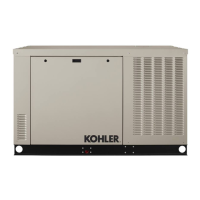The generator set is equipped with a unit-mounted radiator common cooling system. Add coolant before starting the generator
set or energizing the block heater.
The system’s major components include three electric fans, a circulating water pump, a radiator, and a thermostat. The pump
circulates water through the engine until it reaches operating temperature. Then the engine thermostat opens, allowing water
circulation through the radiator. The thermostat restricts water flow as necessary to prevent overcooling. The fans blow air
through the radiator across the cooling surface.
Some generator sets are equipped with an optional block heater.
Note:
Block Heater Damage. The block heater will fail if the energized heater element is not immersed in coolant. Fill the cooling
system before turning on the block heater. Run the engine until it is warm, and refill the radiator to purge the air from the system
before energizing the block heater.
Follow the instructions below to fill the cooling system.
1. Close the radiator’s coolant drain valve and tighten the hose clamps.
2. Remove the cover plate on the top of the enclosure to access the coolant fill. See Figure 28.
Note:
Do not add coolant to a hot engine. Adding coolant to a hot engine can cause the cylinder block or cylinder head to
crack. Wait until the engine has cooled.
3. Fill the radiator with the recommended coolant mixture of 50% ethylene glycol-based long-life coolant and 50% clean,
softened water to inhibit rust/corrosion and prevent freezing. See Figure 28 for coolant fill location. Do not replace the
pressure cap at this time.
Note:
A coolant solution of 50% ethylene glycol provides freezing protection to -37˚C (-34˚F) and overheating protection to
129˚C (265˚F). A coolant solution with less than 50% ethylene glycol may not provide adequate freezing and
overheating protection. A coolant solution with more than 50% ethylene glycol can cause engine or component damage.
Do not mix long-life coolant and conventional coolants. Do not use alcohol or methanol antifreeze or mix them with the
specified coolant.
4. Check the oil level before operating the engine.
5. Operate the engine with the radiator’s pressure cap removed until the thermostat opens and the radiator upper hose
becomes hot.
6. Stop the engine and allow it to cool.
7. Add coolant to the radiator to just below the overflow tube on the filler neck. See Figure 28.
8. Replace the radiator’s pressure cap.
9. Maintain the coolant level in the coolant overflow bottle between the High and Low markings. See Figure 28 for the
coolant overflow bottle location.

